How has gender diversity on corporate boards and leadership teams developed in the past year?
How has gender diversity on US corporate boards and leadership teams tracked over the past year? In this article, we leverage Altrata’s executive intelligence to uncover insights on gender diversity at S&P 500 companies. We examine annual and quarterly changes at the board and leadership team1 level, investigate the key roles of influence and examine the gender diversity of companies led by a female CEO or chair. We also conduct an in-depth analysis of the new female class of 2025, shedding light on the skill sets and characteristics of the women who have joined leadership teams this year.
Gender diversity: the brakes are on
In contrast to sustained progress made over the best part of a decade2, the first half of 2025 brought a year-on-year decline in the share of women on the boards and leadership teams of companies in the S&P 500.
When women occupy the top executive roles at large, listed organizations, they tend to exert a positive influence on senior executive gender diversity.
The share of women on S&P 500 boards declined by one percentage point to 33.7% in the year to Q1 2025. The share then stalled in the second quarter at 33.6%. The story was similar for S&P 500 leadership teams. The share of women fell 0.6 percentage points to stand at 27.9% in the first quarter; followed by another small decline in the second quarter to 27.7%. While it’s important to note that the share of women in these crucial roles remains higher than in 2023, the recent decline is striking because it marks the first time for many years that annual progress has clearly halted.
What lies behind the recent figures? The change in government directives on diversity, equity and inclusion (DEI) initiatives amid a general shift in the socio-political climate in the US may have played a role, along with economic uncertainty holding back diversity programs3.
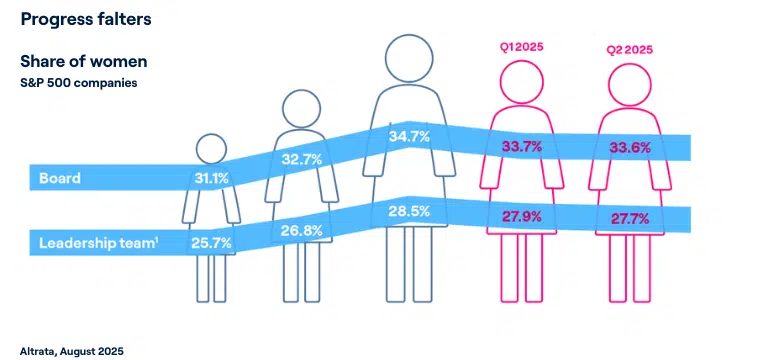
However, employee diversity remains a business imperative for many organizations and, for them, it represents business as usual. Diversity is seen as one component of a wider recruitment strategy designed to ensure a company’s senior executives (and other staff) have highly diverse skill sets and a broad array of experience deemed essential for creating commercial value and future-proofing the business4.
It remains to be seen but it is possible that the overall share of women in leadership teams may improve over the second half of 2025. Looking just at new appointees to S&P 500 leadership roles in the year to May (as opposed to all individuals in these roles), the share of women rose to 30.4%, which is higher than the overall levels in Q1 and Q2 2025. However, this was tempered by the 26% share of women in new board roles in 2025, which fell below the overall levels in Q1 and Q2 2025. (We should note that, as new appointees only account for around 10-20% of overall leadership roles, both these figures will be diluted by the existing mix.)
A woman at the top makes a difference
When women occupy the top executive roles at large, listed organizations, they tend to exert a positive influence on senior executive gender diversity. Our data shows that S&P 500 companies led by female CEOs have a noticeably higher share of women on their boards and leadership teams than S&P 500 companies with male CEOs.
For example, in the first quarter of 2025, women comprised 39% of S&P 500 company boards led by female CEOs, compared with a lower 33.7% among all S&P 500 companies. Looking at S&P 500 leadership teams, companies with female CEOs also had a higher share of women – at 33.6% compared with 27.9% – than among S&P 500 companies as a whole. Companies led by a female chair also showed a more balanced gender make-up on their boards and leadership teams.
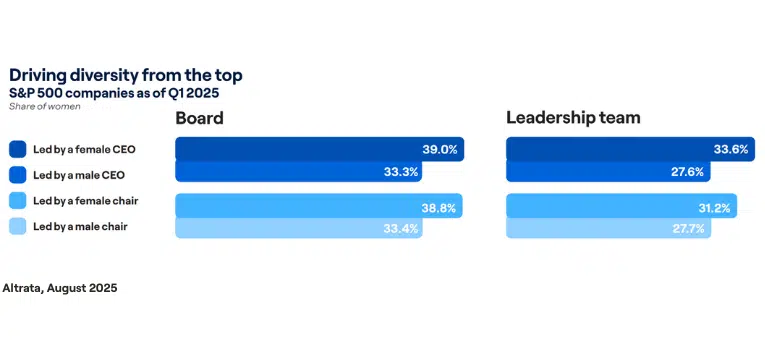
Moreover, individual chairs can make a difference in improving the gender diversity of their company’s leadership team, though this typically takes some time. Our research shows that over their tenure so far, current S&P 500 chairs have overseen an improvement of seven percentage points in the share of women on their leadership teams5. Yet companies with female chairs have seen a greater improvement: of 10.2 percentage points in comparison with a 6.7 percentage point improvement among those companies led by male chairs. The chair is typically the architect of a company’s overall strategic direction and governance, all the while supporting the CEO in implementing this direction, which includes building and steering the leadership team (though over 40% of S&P 500 chairs also serve as CEO). Those at the top, regardless of gender, make a difference.
When women are part of the senior executive suite, they are still finding it difficult to break into the most powerful executive roles.
What lies behind the greater gender diversity of senior executives at S&P 500 companies led by women? It could be down to female leaders driving gender-diverse recruitment explicitly or it could be their more subtle influence on overall culture – possibly both6. Either way, the findings show the positive effect of women taking up the most prominent roles at some of the country’s largest companies.
Getting there is the hard part
When women are part of the senior executive suite, they are still finding it difficult to break into the most powerful executive roles. Among S&P 500 executive directors7, less than 9% are women (in Q1 2025), and there has been little improvement in this figure since the previous year.
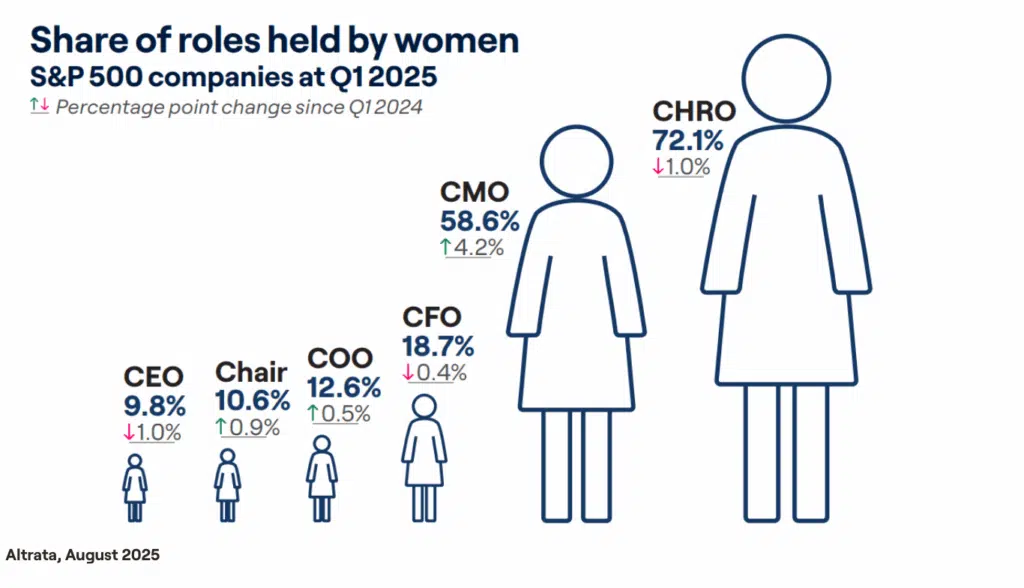
The share of women in the CEO, COO and chair positions all hover at 10-12%, with only the last of these showing any significant year-on-year improvement. Women are a little more numerous in the CFO role, making up around 19%, though this figure does show a slight contraction since the previous year.
In roles that are less focused on executive decision making but still come with influential oversight, women continue to do noticeably better and fill most of these positions, accounting for 72% of CHROs and 59% of CMOs.
How is the class of ’25 shaping up?
What are the characteristics and previous experience of the women who have taken up roles in S&P 500 leadership teams so far this year?
When it comes to professional experience, they are a group with a diverse skill set. Merger and acquisition (M&A) experience is particularly evident, with 82% having accrued at least one experience at a senior level, ensuring that the newest cohort of female leaders will have significant deal-brokering and post-deal restructuring experience. Our data also shows that male and female appointees have similar levels of M&A experience.
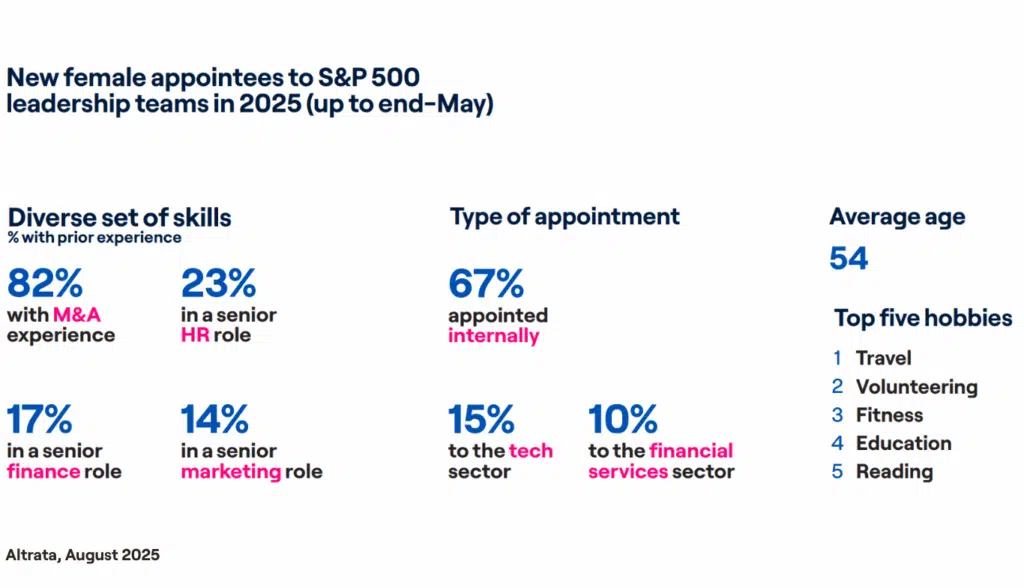
Most (67%) of this latest female cohort have been appointed internally, a lower proportion than their male counterparts (76%), possibly indicating that women find the internal promotional ladder and male-dominated networks more difficult to negotiate. It is also a nod to the well-known ‘pipeline’ issue, where there are fewer women in a company with the experience necessary to progress to the most senior C-suite roles8.
The average age of a new C-suite appointee is 54 for both men and women, meaning they are on similar timeframes in terms of promotion. There is also parity in senior financial and sales experience. However, new male appointees are more likely to have held senior operations and technology roles than their female counterparts, though more female appointees have fulfilled a senior HR role previously, a nod to their dominance among current S&P 500 CHROs.
In terms of outside interests, the staples of fitness and travel feature in the top five hobbies for women. However, the presence of philanthropy and volunteering reinforce the perception of female leaders as willing to look beyond their company to see what’s happening out in the community. In an age when stakeholder opinion and sustainability are increasingly significant, such a mindset will be invaluable.
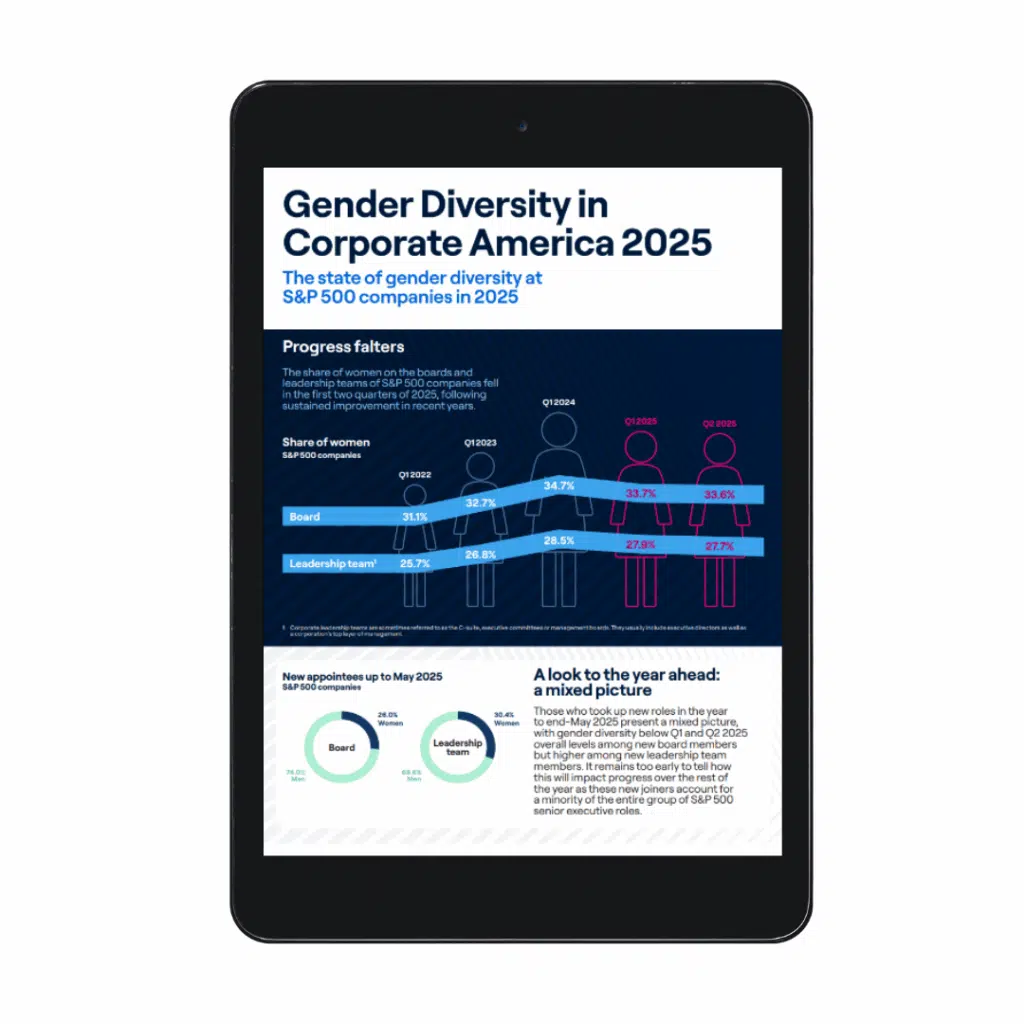
Download: Gender Diversity in Corporate America 2025
Methodology
This report was based on analysis from Altrata’s BoardEx, using its unique and proprietary Global Leadership Database, which covers board and non-board members, C-suite executives, senior leaders and professional advisers. The database contains millions of profiles of public, private and not-for-profit organizations and the people who work for them. For our analysis, we study the individuals who make up the current board and leadership teams at the corporations that make up the S&P 500 index.
All BoardEx data is collected from credible, published sources and cannot be edited by users. Our data is powered by a team of skilled analysts, who research, verify and maintain these profiles. Data details include current and historical roles (with start and end dates) for board positions, employment and education, among others.
Footnotes
1 Corporate leadership teams are sometimes referred to as the C-suite, executive committees or management boards. They usually include executive directors as well as a corporation’s top layer of management.
2 Altrata. Global Gender Diversity 2024, p8.
3 Forbes, August 31, 2024. “The corporate retreat from DEI: a short-sighted strategy?” https://www.forbes.com/sites/aliciagonzalez/2024/08/31/the-corporate-retreat-from-dei-a-short-sighted-strategy/
4 Advocate.com, May 21, 2025. “These 25 major companies still have DEI practices.” https://www.advocate.com/news/companies-keeping-dei#rebelltitem13
5 To ensure a reasonable degree of comparability, we only included chairs who had been in their role for a minimum of three years (the average time these individuals had been in the role was 5.8 years). In addition, the company’s leadership team had to comprise at least five people when the chair took up their role.
6 Altrata. Global Gender Diversity 2023, p6.
7 Executive board members, the most prominent being the chief executive officer (CEO), have real decision-making power in corporations and often command significant resources. Aside from a few exceptions, executive directors are appointed to the board in most countries.
8 Altrata. Global Gender Diversity 2023, p16.
About the author
Maya Imberg is the Head of Thought Leadership and Analytics at Altrata. She is responsible for spearheading the company’s thought leadership efforts and overseeing its analytics and predictive modeling services commissioned by clients. She joined Altrata’s Wealth-X in 2016 as Director of Custom Research responsible for secondary research, data analytics and branded content. Maya has over fifteen years of experience in research, spanning market research, macroeconomics and financial services. Prior to joining Wealth-X, Maya held a variety of consultant and economist roles at the Economist Intelligence Unit and spent a number of years working for Datamonitor’s Financial Services practice. Maya holds an undergraduate and MSc degree in economics and comparative politics from the University of Pennsylvania and London School of Economics respectively.